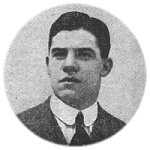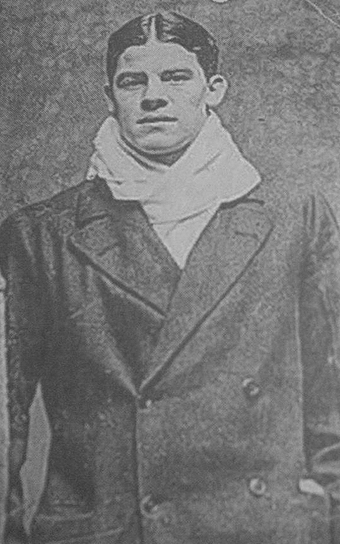Charles Eugene Williams
Second class passenger

“The Captain did ask what became of First Officer Murdoch. We told him that he had blown his brains out with a revolver. Upon hearing this, Captain Smith pushed himself away from the boat, took off his lifebelt, and sank beneath the surface.."
Triumph and Tragedy lists a 23 year old “Williams, Mr. Charles Eugene” from Harrow England who boarded Titanic at Southampton, traveling second class (p.349) (7.).
Encyclopedia Titanica provides the following information:
“Williams was a squash racquets player. According to contemporary reports he and was traveling to New York to defend his title. Williams told reporters that he had left the squash racquet court at 10.30p.m. and had gone to the smoking room. When he heard the crash he rushed out and saw the iceberg which he said rose a hundred feet above the deck. The iceberg broke up amidships and drifted away. Williams said he jumped as far as he could from the side of the Boat Deck on the starboard side. He added that the boat he had to stand in water up to his knees in the boat that finally picked him up. As he is not among the known survivors of boat A or B that match this description it is more likely that he got into lifeboat 14 when it was lowered from the deck.” (Philip Hind, Encyclopedia Titanica (8.))
William’s account is “second-hand” in that he related the account to his “friend George E. Standing” who in turn passed it on to reporter for The Daily Sketch. The article was printed on April 30, 1912 (courtesy of Tad Fitch and Bill Wormstedt, Shots in the Dark (12.)):
“I saw Captain Smith swimming around in the icy water with a baby in his arms and wearing a lifebelt. He handed the baby to someone in the lifeboat, but refused to get in himself. The Captain did ask what became of First Officer Murdoch. We told him that he had blown his brains out with a revolver. Upon hearing this, Captain Smith pushed himself away from the boat, took off his lifebelt, and sank beneath the surface.”
The Daily Sketch reporter added:
“It may be stated that there is no official confirmation that Mr. Murdoch shot himself; we give the whole account as it appeared in the New York World. Mr. William's story as to Captain Smith’s death is borne out by statements made by Harry Senior, the Titanic fireman, and others, who, as reported in the Daily Sketch yesterday, said they saw the captain rescue the child.”

23 year old Charles Williams was a squash
racquets player. (Click image to enlarge)
Bill Wormstedt writes regarding this: “The reliability of Williams’ report about Murdoch's suicide is unknown, because it is not clear if he actually saw it, or was just describing what he had heard. Williams appears to have left the ship in Lifeboat 14 (though his own account says he was picked up from the water by a lifeboat), in which case he probably would have not been close enough to the Titanic in its final moments to see a shooting, or to see Captain Smith in the water.” (12.)
The problem with William’s account is the confusion over what lifeboat he was in. Information from Encyclopedia Titanica mentions that Williams himself said, “he jumped as far as he could from the side of the Boat Deck on the starboard side. He added that the boat he had to stand in water up to his knees in the boat that finally picked him up.” This could only refer to collapsible A. However, both Titanica and Bill Wormstedt seem to think that he left the ship in lifeboat 14, the reason being that “he is not among the known survivors of boat A or B”. Interestingly, Fifth Officer Lowe, in charge of lifeboat 14, transferred the occupants of the swamped collapsible into his lifeboat, which may be the source of the confusion. It is feasible that Williams was in both collapsible A and transferred to No.14, thus accounting for the seeming discrepancy.
Williams adds yet another version to the many different ways in which Captain Smith met his fate, and if it happened at all, there is no way in which Williams would have been able to verify the identity of the individual concerned under such dimly lit and chaotic circumstances. Like many such accounts, it is more likely based upon wishful thinking that the person they saw was indeed the Captain. But it does include an intriguing addition that ties in Smith’s demise with that of Murdoch’s, Smith giving up all hope upon hearing of his First Officer’s suicide. The inclusion of the term “we” indicates that at least several were familiar with what allegedly happened to Murdoch, but as Wormstedt points out, there is no way of telling whether William’s personally saw the suicide or not.
Conclusion
Williams adds yet another version to the many different ways in which Captain Smith met his fate, and if it happened at all, there is no way in which Williams would have been able to verify the identity of the individual concerned under such dimly lit and chaotic circumstances. Like many such accounts, it is more likely based upon wishful thinking that the person they saw was indeed the Captain. But it does include an intriguing addition that ties in Smith’s demise with that of Murdoch’s, Smith giving up all hope upon hearing of his First Officer’s suicide. The inclusion of the term “we” indicates that at least several were familiar with what allegedly happened to Murdoch, but as Wormstedt points out, there is no way of telling whether William’s personally saw the suicide or not.
Verdict: